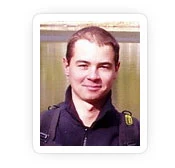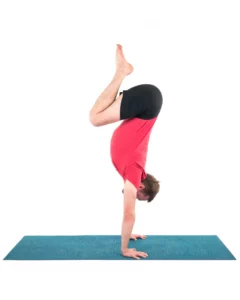Yoga Anatomy: “Easing In” to Chaturanga Dandasana

I recently published a post that focused on the hip abductors and adductors and how they can be used to stabilize the pelvis and synergize flexing the hips in forward bends. In this post, we’ll look at a technique that can be learned with Chaturanga Dandasana (Four-Limbed Staff Pose) and then transported to other poses to improve benefits and safety. I call this technique “ease in, ease out,” and it relates to how one approaches the endpoint of a pose.
For this cue, I take a yoga block and place it at the level of my sternum, then lower down to lightly touch it from Phalakasana (Plank Pose). I then straighten my arms to return to Plank. The image that bodyweight practitioners use for this is “kissing the baby” because one touches the block as gently as kissing a baby on the forehead. Working in this manner teaches muscle control and sensitivity.

Figure 1
Those who avoid full Chaturanga Dandasana due to weakness of the muscles involved can develop the strength for the full pose by starting at a wall, as shown in figure 2. Here, instead of the chest touching the block, bend the arms to lower toward the wall and gently touch the forehead, hold for a moment, and then straighten the arms. Work in this manner until you can comfortably do ten repetitions. As strength builds, transition to Plank with the knees on the mat, lowering down to touch the block as in the final version. (Figure 3)


Figure 2 at the wall above and Figure 3 with knees down
Visualizing the muscles involved is a powerful adjunct to this technique. Use a mental image of the triceps, pectoralis major and serratus anterior muscles engaging in stabilizing the arms, shoulders, and chest, as shown in figure 4. The triceps straighten the elbows and is a secondary stabilizer of the shoulder joint. The pectoralis major draws the upper arm toward the midline (adduction) and helps to expand the chest (when the shoulders are held in place). The serratus anterior extends from the upper nine ribs to the inner (anterior) medial surface of the scapula. It acts in concert with the rhomboids to stabilize the shoulder blades and thus prevent “winging” of the scapula in this pose. (Figure 4 below)

Figure 4
Slowing the movement as one approaches the endpoint of the pose also sets up a cadence or rhythm, especially when working with a vinyasa flow-based practice. It can be applied to any pose and also to inhalation and exhalation, thus smoothing the breath. It also aids in protecting the joints, which have smooth curved surfaces that adapt best to gradual transitions during movement.
Reprinted with permission from the Daily Bandha.
 Author, Ray Long MD FRCSC is a board-certified orthopedic surgeon and the founder of Bandha Yoga. Ray graduated from The University of Michigan Medical School with post-graduate training at Cornell University, McGill University, The University of Montreal, and Florida Orthopedic Institute. He has studied hatha yoga for over twenty years, training extensively with B.K.S. Iyengar and other leading yoga masters.
Author, Ray Long MD FRCSC is a board-certified orthopedic surgeon and the founder of Bandha Yoga. Ray graduated from The University of Michigan Medical School with post-graduate training at Cornell University, McGill University, The University of Montreal, and Florida Orthopedic Institute. He has studied hatha yoga for over twenty years, training extensively with B.K.S. Iyengar and other leading yoga masters.
 3d Graphic Designer / Illustrator Chris Macivor has been involved in the field of digital content creation for well over ten years. He is a graduate of Etobicoke School of the Arts, Sheridan College and Seneca College. Chris considers himself to be equally artistic and technical in nature. As such, his work has spanned many genres, from film and television to videogames and underwater imagery.
3d Graphic Designer / Illustrator Chris Macivor has been involved in the field of digital content creation for well over ten years. He is a graduate of Etobicoke School of the Arts, Sheridan College and Seneca College. Chris considers himself to be equally artistic and technical in nature. As such, his work has spanned many genres, from film and television to videogames and underwater imagery.



